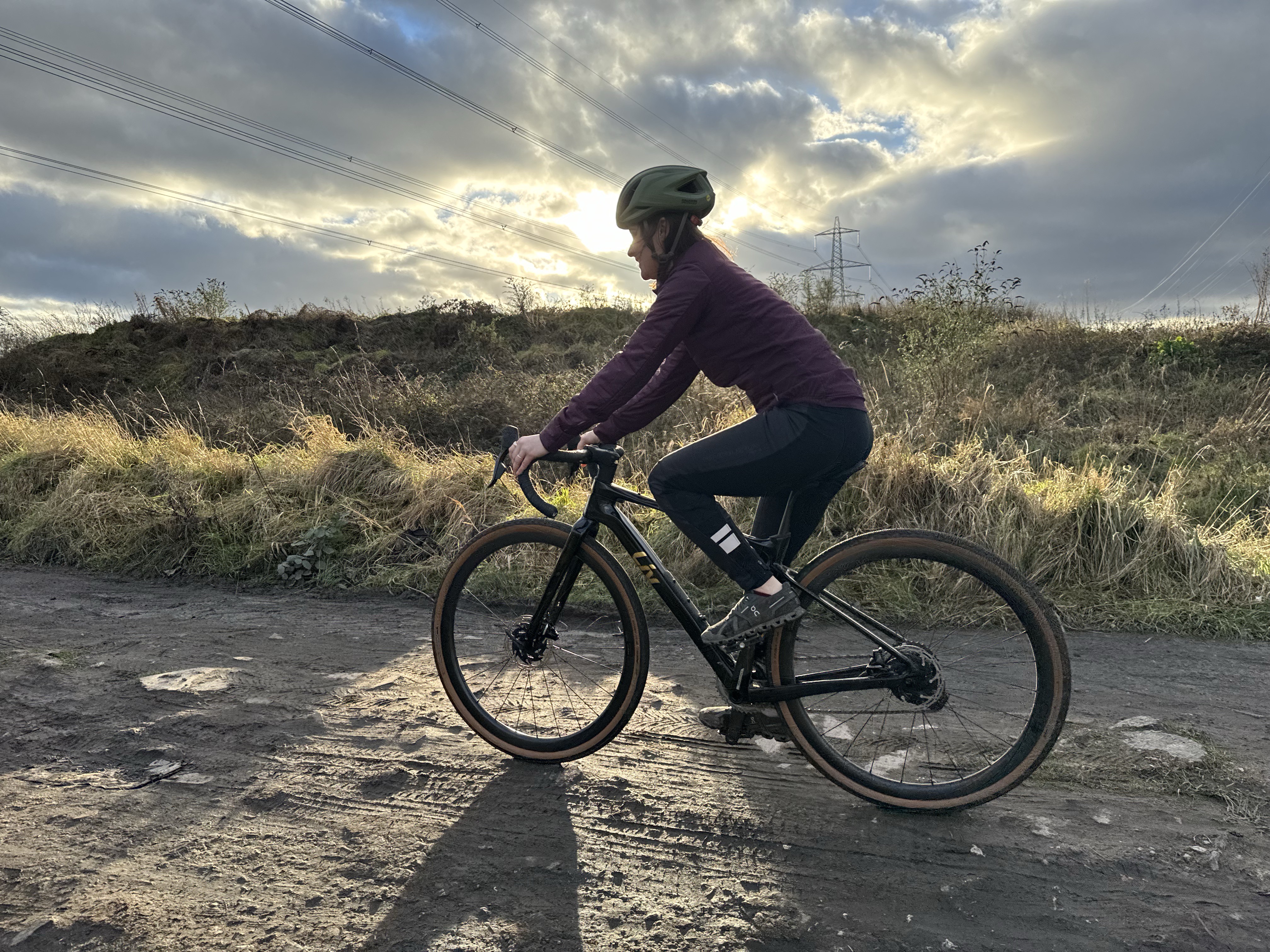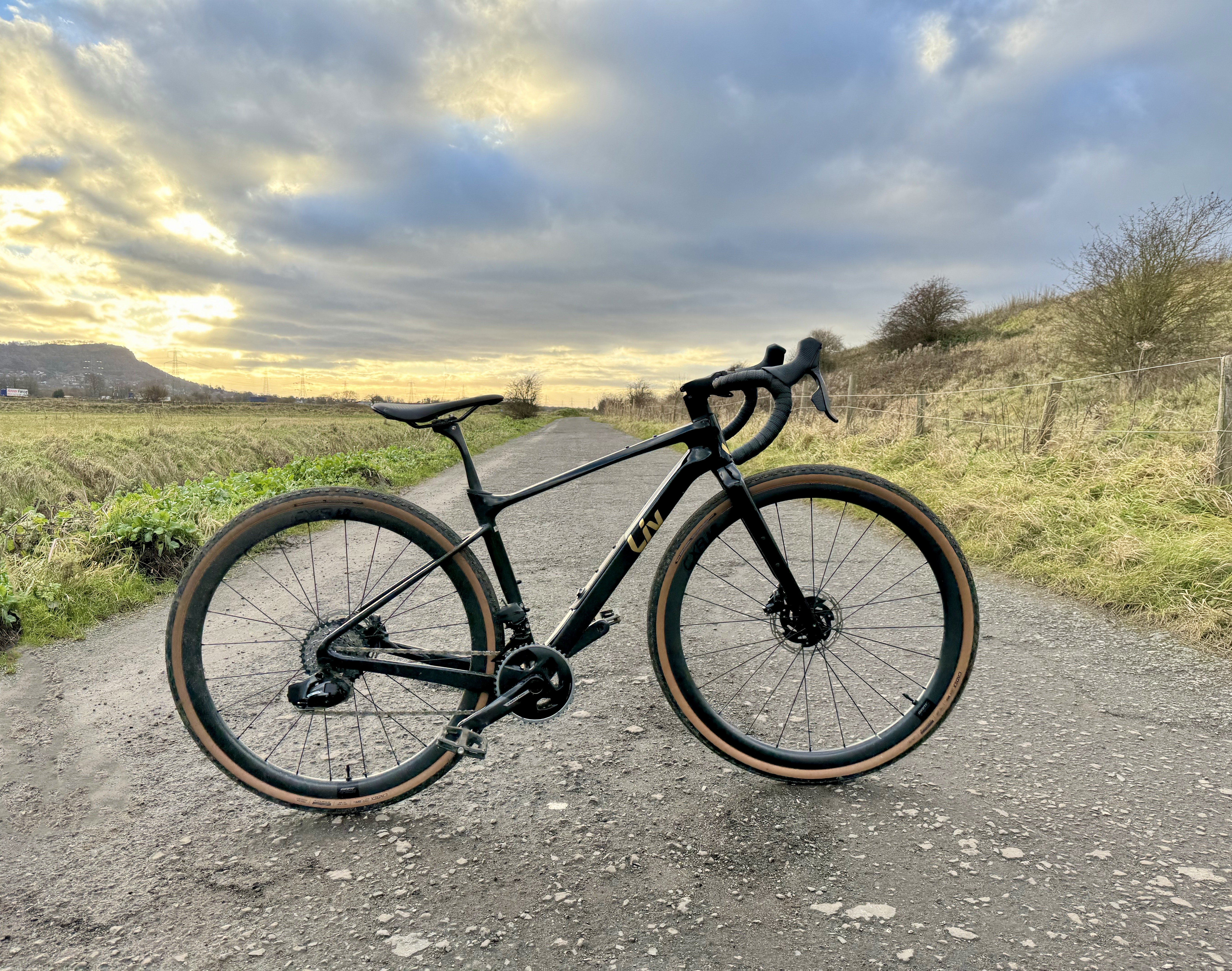
Gravel bikes are evolving to cater to a burgeoning racing scene, with the top end bikes becoming lighter, more specialised and able to handle power transfer better than their earlier plaid-shirt counterparts. Like road bikes before them, we’re witnessing the carving out of niche identities, with riders looking to differentiate themselves.
The latest iteration in this evolution is Liv’s Devote Advanced Pro, a women’s specific elite gravel racing bike, boasting impressive specs and an even more impressive aesthetic. The Devote has been a stalwart of Liv’s range since 2020, witnessing numerous upgrades and fine-tuning year on year, culminating in 2024’s new advanced model featuring an ‘aggressive’ geometry, integrated frame storage and flip chip dropouts. It’s exciting to witness a more concerted effort by brands to take women’s racing seriously, and with an impressive repertoire of elite bikes and racing sponsorships in their arsenal, it is no surprise that Liv has pushed the boat out on this bike, leaning heavily into both the racing and adventure riding scene.
Liv offers a high spec across seven models in the Devote range: The Devote Advanced Pro (the model I am reviewing here), the Devote Advanced (with models 0, 1 and 2) and the Devote (also with models 0, 1, and 2). All frames come with the flip chip technology on the rear dropout that allows the rider to alter the wheelbase slightly, as well as a medley of ports for mudguards and bikepacking equipment. The main difference between the models is the framesets and varying components to offer a broader price spectrum, with both the Advanced Pro and the Advanced aimed at elite gravel racers with fully carbon composite frames, while the Devote is geared more towards the everyday adventurer and utilises a lightweight alloy frame.
I would like to be clear that I am not an elite gravel rider; I’ve never participated in a gravel race, nor had I, until testing the Liv Devote for this very review, ever even participated in any bike race. Despite this – and despite Liv’s marketing - I actually think I’m exactly who the Liv Devote is tailored towards: an adventure rider looking for versatility from a bike that can cope with big weekend adventures but with the capabilities to push further in my riding.
For this review, I wanted to test this bike as widely as possible. I relegated my faithful steel framed gravel bike to the shed and threw everything from quiet Cheshire lanes, the wide premium fire tracks of the local forest, to the gnarly ‘probably-hardtail-territory’ techy gravel over the Clwydian range. I used it as a commuter and loaded it up with bikepacking gear to see how it would handle a longer adventure. I even entered it into the National Hill Climbing Championships (where it fared much better than I did).
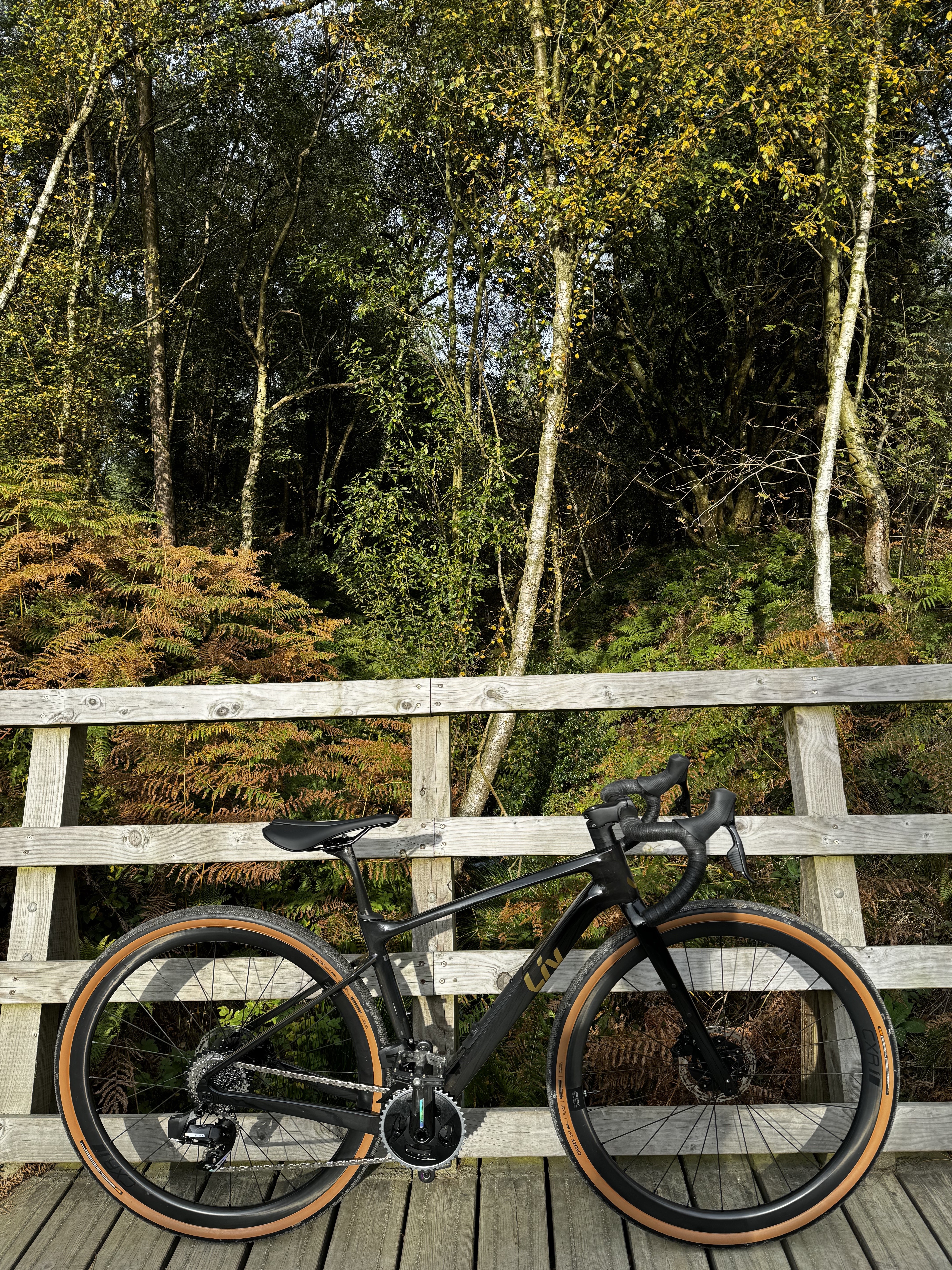
Design and Aesthetics
If you bought the Devote purely for its looks, I don’t think I could say I blame you. Gone are the days of the industry ‘shrink it and pink it’ strategy for women’s bikes, and instead enter in the sophisticated Liv Devote Advanced Pro: grown up and unfussy in its design.
The integrated cabling in the headset gives it crisp, sleek lines and Liv has used a lacquered, glossy, piano black paint flecked very subtly with gold to match the accents (including a tiny little compass on the seat post), giving it a scintillating depth in the sunlight. Polished up, this is a real head-turner, and I did indulge in that a little bit. I felt good riding it. The paint does, however, attract fingerprints, and I was disappointed to find that after 30 seconds of handling the bike, it had dulled as if a sticky-fingered toddler had got hold of it. I spent a lot of time rubbing the top tube quickly with my sleeve to keep it shiny. That was a bit annoying.
Beyond the paint though, the Devote is simply and intentionally designed. The frame and fork are Giant’s advanced-grade composite, offering a low weight yet reasonable stiffness. Like many carbon bikes, Liv has chosen to add integrated downtube storage as a little something extra, and I assume, so as not to wreck that lovely aero aesthetic up front with a cumbersome bar bag. While I find them slightly gimmicky in concept, I was able to fit a multi tool and hand pump inside, which was useful on shorter routes. I did have to keep them wrapped in a sock to dampen the annoying rattle that accompanied it, but I believe that was a symptom of using a test bike; Giant says a waterproof bag is included for paying customers.
As a small-limbed 165cm (5ft 5in), I went with the small size, toying about whether to go for the fairly rare XS on offer (for those approximately 150cm or 4ft 9in to 163cm or 5ft 3in). Sizing is slightly limited in the UK on the upper end, only going up to a Medium for those at 175 cm or 5ft 8in, which is disappointing to see as it would size out a number of my taller friends who I know would have loved this bike. For me though, happily, the small felt right.

Performance
I found the Liv Devote incredibly fast and powerful, no matter what terrain I opened it up on. It flitted easily between gravel, muddy bridleways and tarmac almost effortlessly, remaining sprightly and lightweight in my hands, and particularly shone climbing steeper more technical gravel sections where I was (to my great surprise) almost always able to hold momentum.
Liv has implemented Giant’s OverDrive2 in this latest iteration of the Devote, utilising an oversized headset bearing and tapered steerer tube. Giant claims this increases torsional steering stiffness by 30%, and while I am still not totally sure I fully understand the technology, it did translate into incredibly nimble, clean and light steering. Particularly on inclines, I could make lots of precise little adjustments to find the best lines quickly while climbing, making for very enjoyable, challenging riding.
This experience was pretty consistent over the rest of my riding too. Out of the box, the Devote Advanced Pro comes with SRAM’s Force AXS wireless groupset, including a double chainring on the front, which was a surprise to me. I’d expected it to be a bit of a pain to shift between the large and small rings, anticipating that I’d probably avoid the larger of the two off-road, but the shifting was so clean and fast that I quickly came to love the versatility of it. This was my first experience of SRAM Force and I was impressed. With the 12-speed groupset, I could be impeccably precise with my gear changes; the spacing between them meant I could get a comfortable cadence whatever the speed, and the wide range meant that I could stay much longer in one chainring before having to shift. On sudden unexpected climbs I could quickly and seamlessly adjust my gearing perfectly as the elevation increased. On the flat, I had enough gears to keep me at a good cadence, and I found road riding just as enjoyable as on the trail. I also really enjoyed the customisability of it, taking great enjoyment in messing with the various settings through the app.
Though I was largely impressed with the groupset, I did get far less than the advertised 60 hours of battery life which I partially blame on the cold weather. I realised this error of judgement 20km and two big climbs away from my car and cursed my naive faith in advertised battery life. I noticed afterwards that the SRAM app had a ‘ride readiness’ meter that would have alerted me to my misjudgement had I bothered to look at it closely enough. Lesson learned.
I entered the Devote into the National Hill Climbing Championships (the route was aptly dubbed ‘The Struggle’), and despite the shouts of the spectators asking me if I was on a mountain bike, I never actually felt like I was on the wrong rig. For a gravel bike, the Devote is incredibly lightweight (Liv doesn’t give official figures but I weighed it at approx 8kg), and it probably comes as no surprise that it sailed up hill after hill with very little difficulty. Despite the 24% gradient over nearly three miles of road, I didn’t run out of gears, and while I was struggling with the hill, it didn’t feel as if the bike was. Would I recommend you enter the Liv Devote into a hill climbing race? With smaller tyres than the supplied Cadex AR gravel tyres, I don’t think you’d look noticeably out of place.
Speaking of tyres, I think the Cadex AR gravel tyres are some of my favourite manufacturer’s selected tyres of all time. With smooth centre knobs and a taller side tread, they corner exceptionally well – even on mud and in the rain – and feel precise in their handling without losing too much momentum on the roads. At 40mm they handled most terrain impeccably, only really losing grip and spinning out on a near vertical section of chossy gravel towards the summit of a hill that, to be fair, was more hardtail territory than gravel.
I used the Liv as a commuter for a period too, cycling 13 miles from my home along country lanes often strewn with British farming detritus and found, unsurprisingly, that the Liv performed well in that too. I was pleased to find I recorded journey times on the Devote similar to my lightweight road bike, though with the bigger tyres it felt significantly more comfortable.
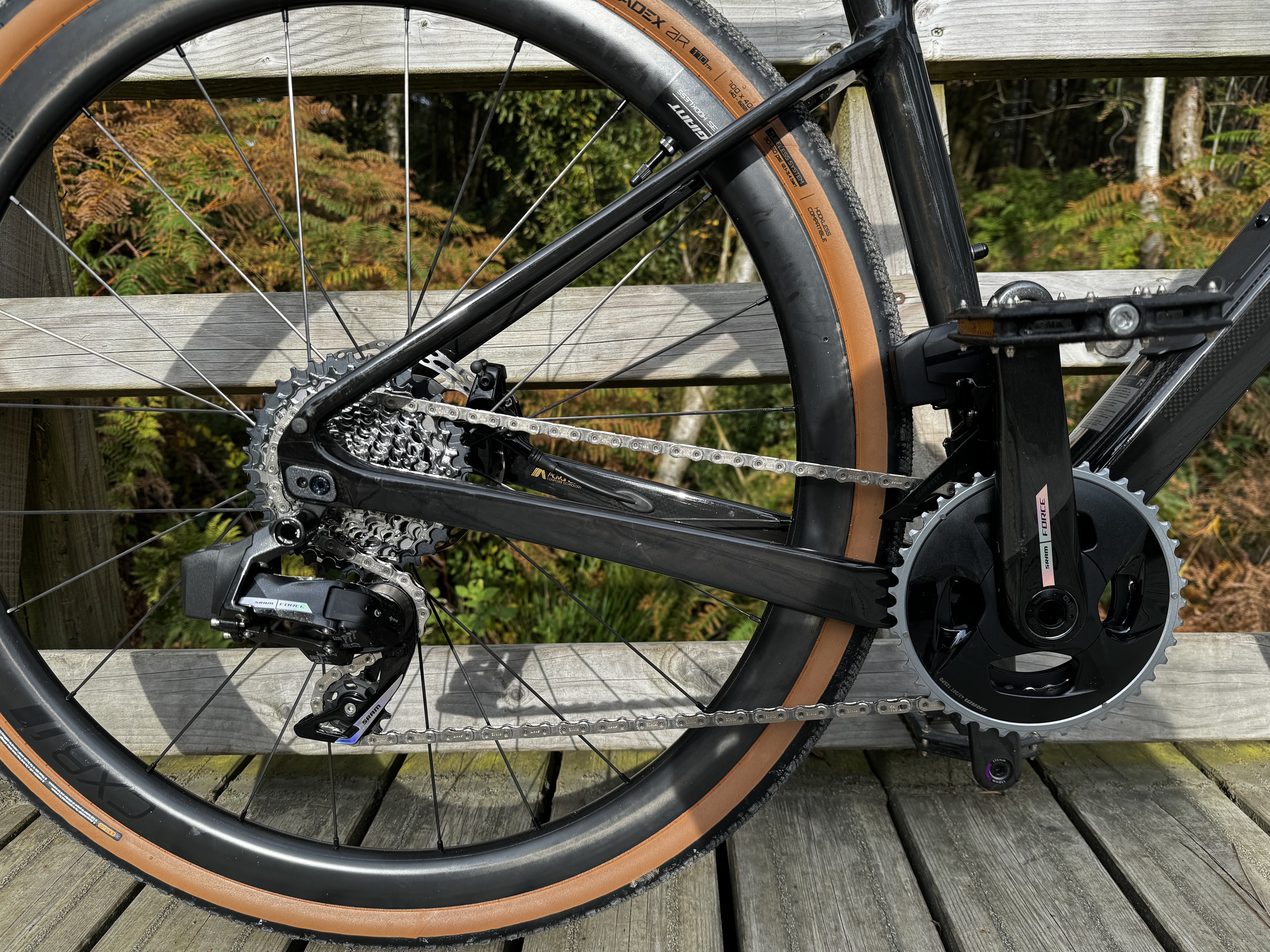
Comfort and Handling
As great as I felt the Liv was on my shorter, local loops, a really great gravel bike needs to be comfortable enough for longer distance adventures. It comes with plenty of points for rigging up your bikepacking gear, so it felt right to test it on longer distance rides. I wanted a bike that I could hop back on day after day without any worry of a dodgy back, neck, elbow or saddle sores and that handled just as comfortably when loaded. I was, admittedly, sceptical. Liv touts that its biggest change in this iteration of the Devote is the ‘more aggressive’ geometry and riding position, which I am not used to, and combined with the phrase ‘elite racing’ in their marketing, does not exactly scream luxury comfort. However, with a slightly higher stack putting me in a more upright position than I’d expect for ‘aggressive geometry’, I was surprised to find that the miles sailed by and that longer days in the saddle on mixed terrain were delightfully comfortable, and still felt light and sprightly even when loaded up.
The success of this was largely down to the ability to fine tune elements of the bike, which I liked – I am a big fan of versatility. For a start, the Devote comes with Liv’s well-known D-Fuse technology in both the seat post and the headset, which allowed for (after a bit of fiddling) a fairly tailored fit. First appearing on Giant’s cyclocross bikes in 2014, Liv has begun to roll this technology out to their gravel bikes to improve comfort, claiming up to a 7mm flex that dampens the worst of the road vibrations. I noticed a significant difference in my wrist and lower back, where I am usually particularly sensitive to the rough stuff and found that even on some of the worst rutted gravel trails, the Devote did an exceptionally good job of keeping things smooth. However, if Liv’s proprietary components are not your bag, you can easily swap out the seat post to a traditional 27.2cm, 30.9cm or if you’re feeling particularly adventurous, a dropper post. Liv’s clean cable-less aesthetic in the headset isn’t just good for aerodynamics, it also houses room for dropper post cables.
My one criticism in terms of comfort on the seating arrangements was the choice of saddle that comes with the Liv Devote as standard: the Liv SL Approach. Most of us swap out our saddles to better performing ones anyway so I won’t dwell on it too much, but I dislike cut-outs as a rule and found this one a bit too harsh in all the wrong places. I found a temporary fix in adjusting the saddle nose down and discovering the adjustable reach on the SRAM AXS brake levels, which allowed for a better riding position with less pressure on bits that don’t need pressure on them. I messed with the adjustable reach a few times while riding to get it just right, though I did find there was a limit in how much adjusting could take place owing to the very large gear paddles.
For me, the Devote really underlines its versatility through the flip chip dropouts, which allow you to alter the wheelbase of the bike, providing additional clearance for your tyres and tailoring the bike for the style of riding you’re doing. A shorter, more compact wheelbase means a sprightly, more reactive ride, whilst a longer wheelbase leans into stability and comfort for endurance and more technical riding. In the Devote, the shorter wheelbase (101.9cm) gives a tyre clearance of 45mm, while the longer wheelbase (102.9cm) provides an ample 53mm. There wasn’t, in my opinion, enough of a performance difference for me to bother with faffing with them mid-ride – say if the terrain changed – but the flexibility of sticking some bigger tyres on and having a more relaxed geometry both improves the ride and opens a whole new world of exploration. I felt I had the option with a bit of foresight to put on bigger tyres and to be more adventurous in my route planning. I know there are some flip chip naysayers out there, as they’ve been a lingering feature of bikes for a few years, but I really liked the versatility it lent to the bike.
Loaded up with my bikepacking bags, I didn’t notice anything significant in the Liv Devote’s handling. The bike still felt nimble and speedy, even on the roads and with fairly heavy bags. I often ride with a front rack, which isn’t every gravel rider’s choice, and found the highly sensitive steering did become a little bit less precise and wobbly but no more than I’d expect.
I’d argue the one place I felt let down by the bike was on descents, which is surprising considering Liv claim the new aggressive geometry gives you more speed and stability downhill. Even with the flip-chips at their relaxed setting, I still struggled on the rockier, more technical descents that you often end up on in British gravel riding, finding that the lightness of the bike, narrowness, lack of bar flare and sensitive steering buffeted me about. At 400mm wide and with only an eight degree flare the bars were perfect on the flat and in most of my riding, and I welcomed the efforts Liv have made to considering a woman’s shoulder width in the design, but I felt unstable and lost my confidence a few times, electing to walk sections I would have happily ridden on my normal gravel bike. Slightly wider bars would have made a difference, and while I think this was partly down to my own riding ability, I also don’t think the bike is built for gnarly or stepped gravel riding. It’s not unbearable but the riding feels less stable, and I wonder how it would fare after a few years of rugged riding.
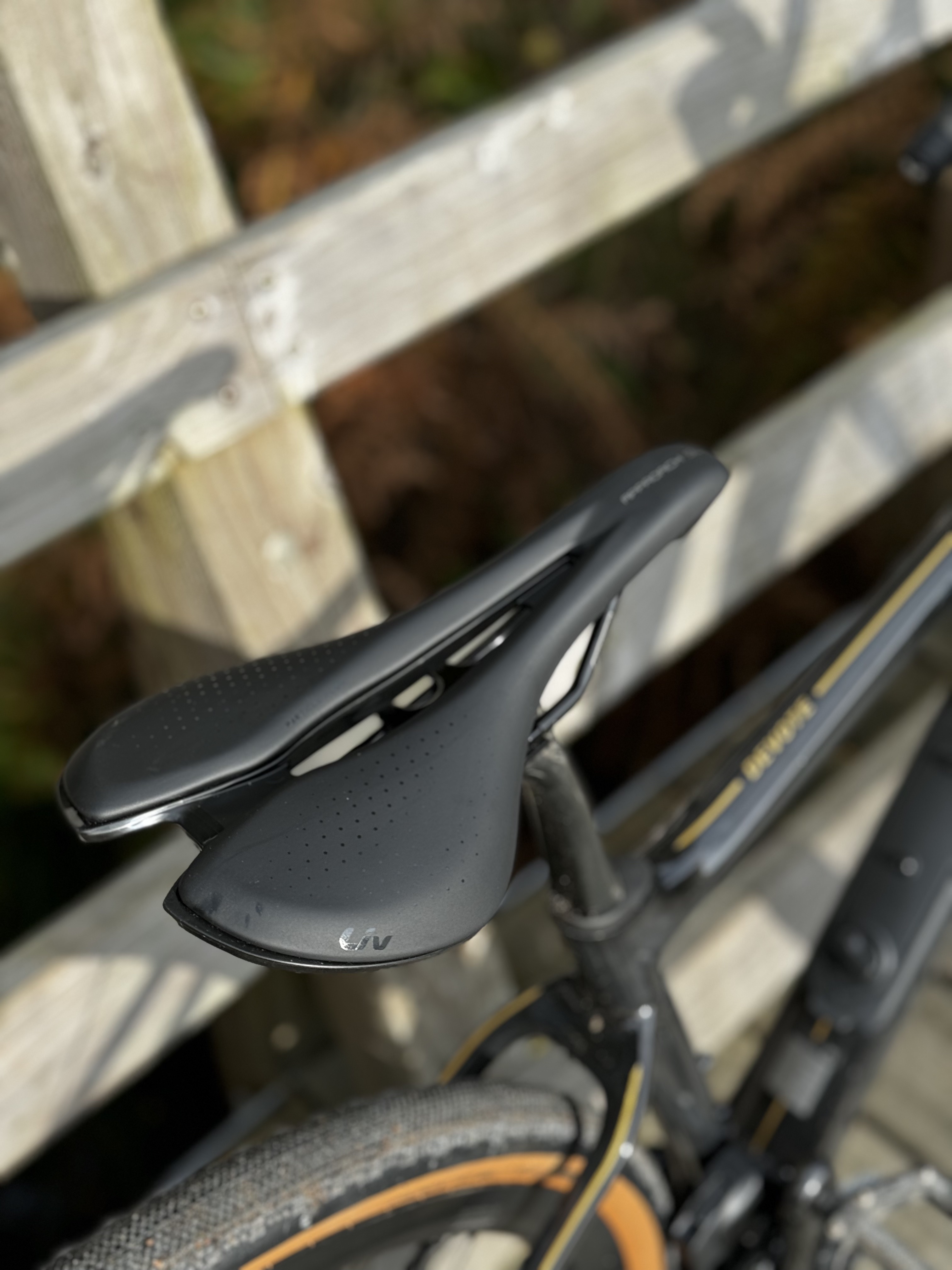
Value
Priced at £5,599 for the highest spec of the Devote Advanced Pro, this is not a cheap bike. However, in comparison to some of the top-range gravel racing bikes on the market at the moment that can reach upwards of £12,000, it isn’t totally unreasonable. Especially when you consider the versatility of the bike, the superb performance on most terrain and the potential to tailor the bike even further, I’d say it’s priced pretty fairly.
You’d be hard-pressed, I think, to find anything else with a similar spec, a women’s-specific design, that could offer both lightweight raciness and long distance comfort. Perhaps the Canyon Grizl CF SLX 8 might offer a rival spec for less, though not by much, and with a slightly longer wheelbase I wonder how sprightly the bike might feel in comparison. If you're serious about your riding and are considering about building out your 2024 racing portfolio, I'd say the Liv Devote Advanced Pro is worth the investment.
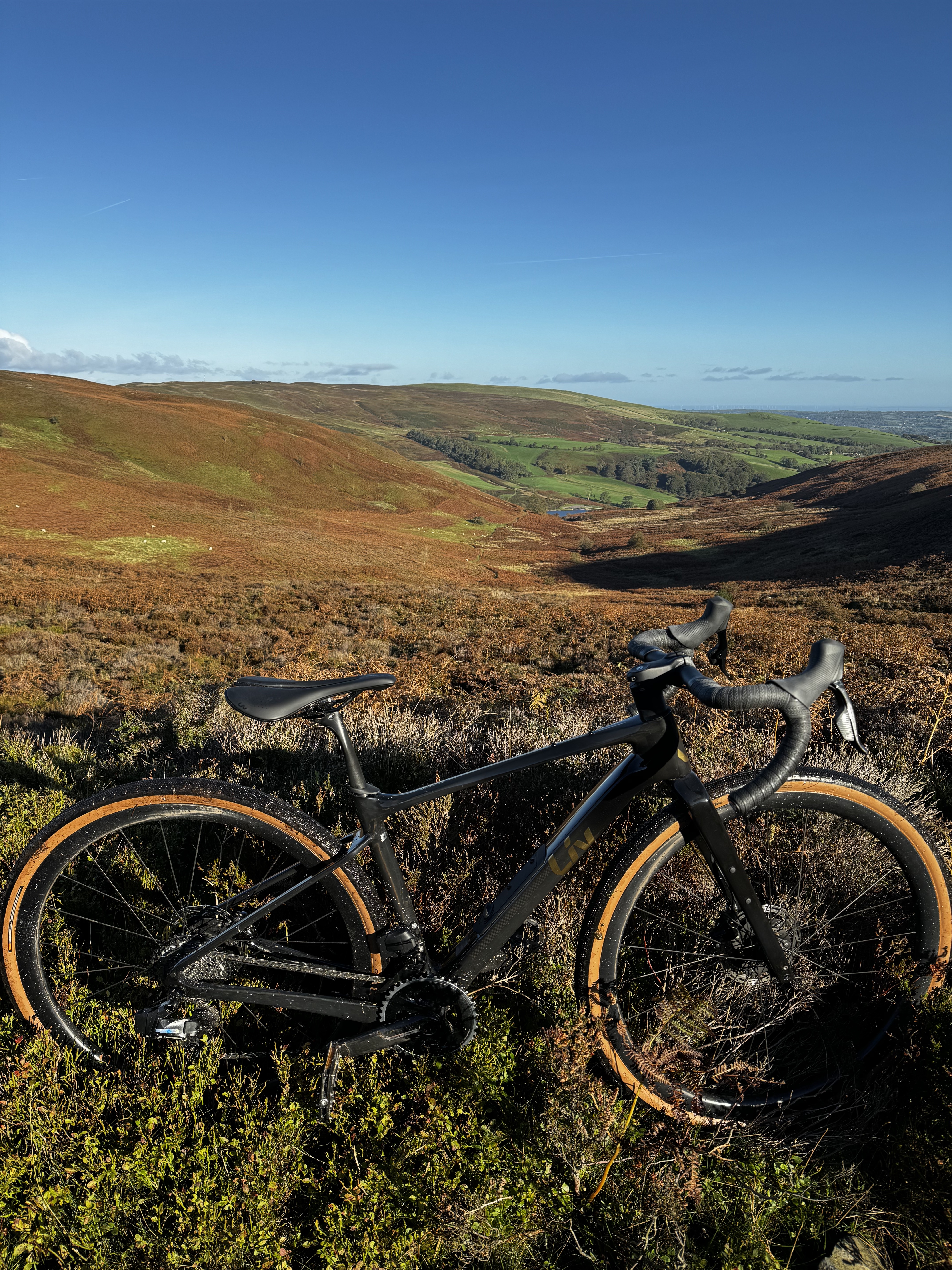
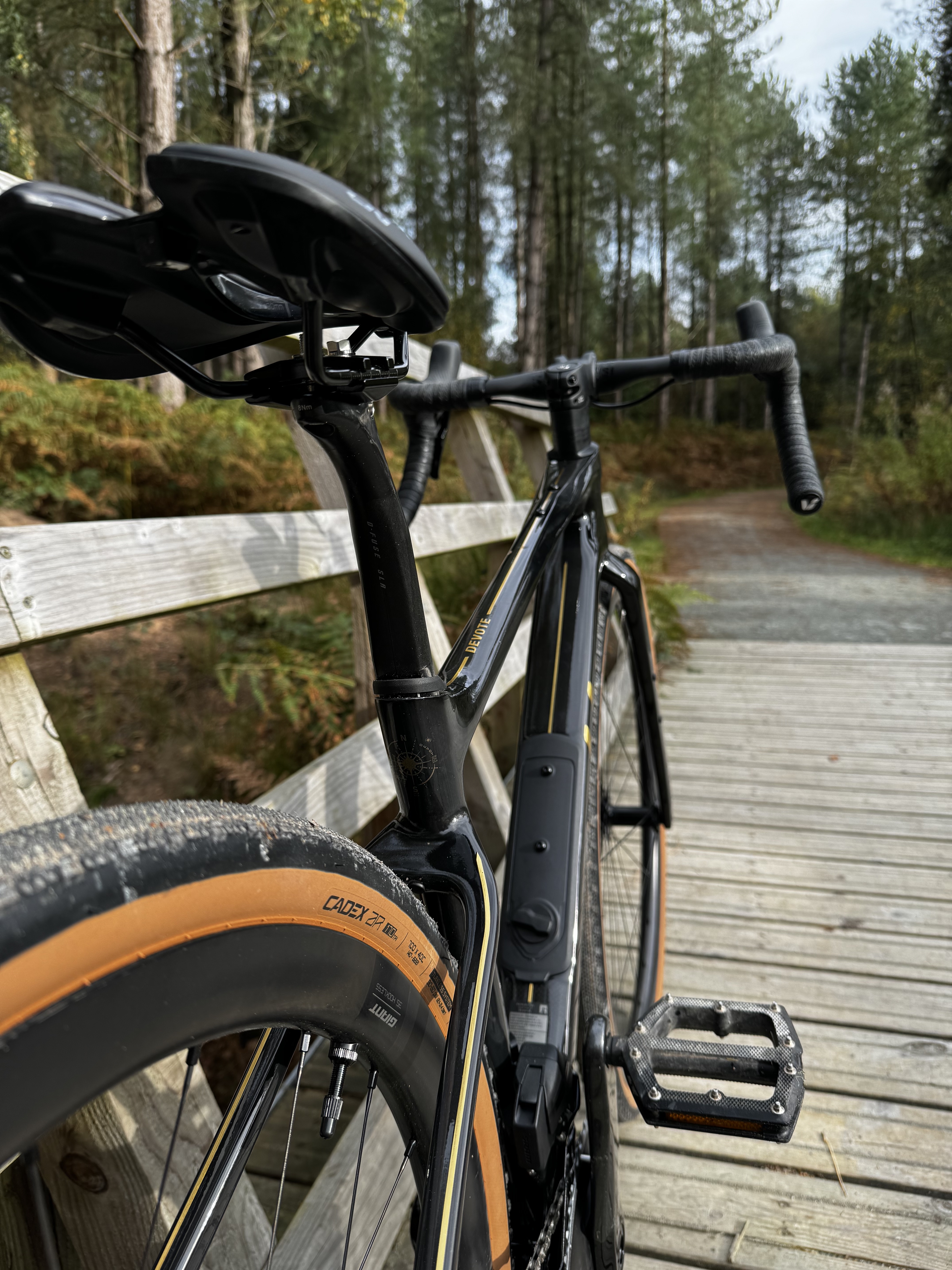
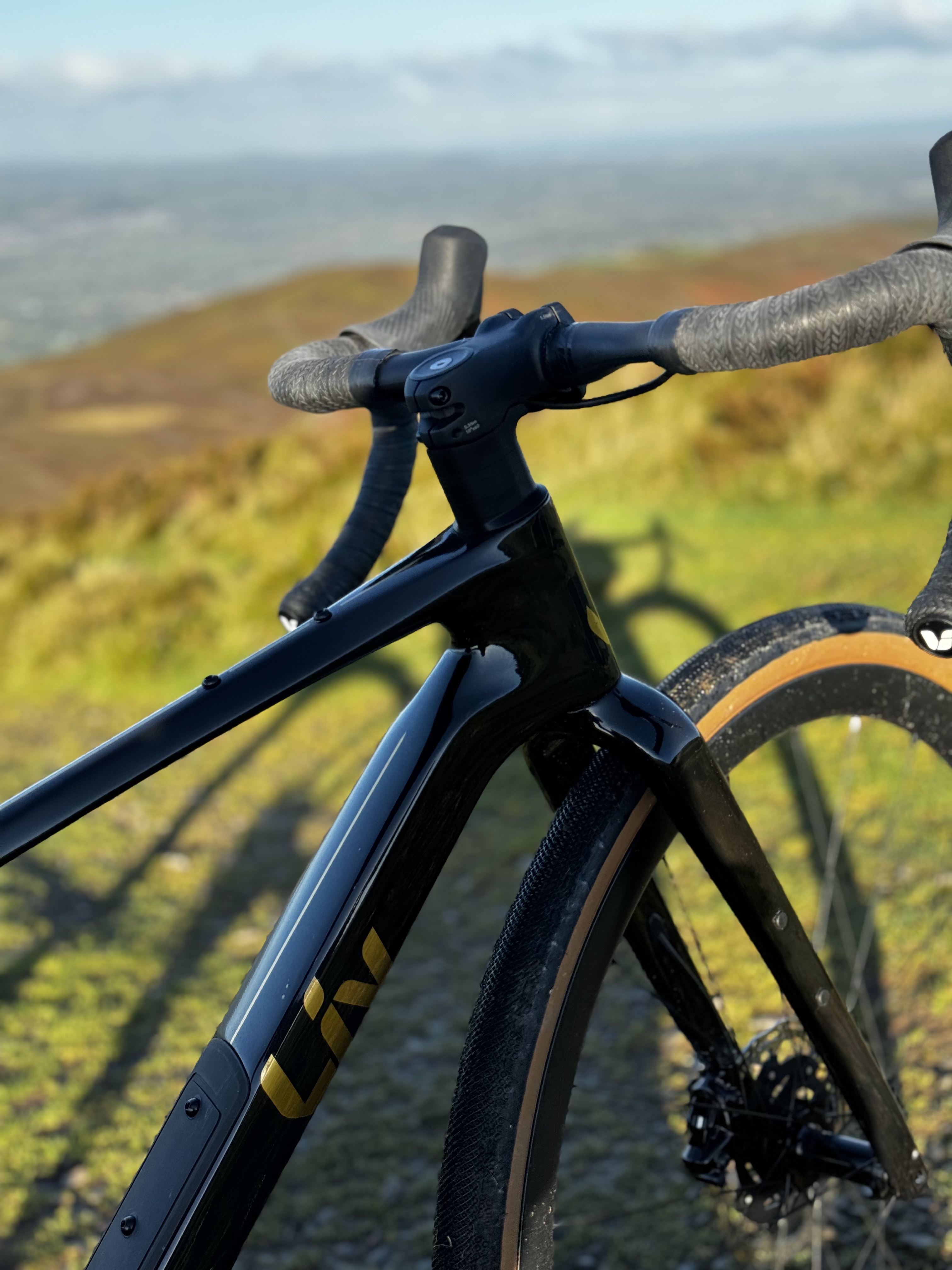
Overall verdict
In short, I loved riding this bike. Liv has done a great job at walking that fine line between exclusivity and broad appeal. I consistently felt that it was a bike I could ‘grow into’, building my confidence as I sought out new routes and riding harder than I have done before. Following the National Hill Climb Championships, I began daydreaming about all the other races I’d like to try out, imagining myself crossing the finish line full of triumph, before remembering I do have to return it to Liv fairly soon. I felt that I could push my limits further, and that I could go for faster, lighter adventures on the Devote. Without sounding too dramatic and putting readers off, the Liv Devote gave me permission to dream a bit bigger, to have a bit more wanderlust and reconsider my potential.
However – and this is a big however – I am still torn about whether this bike is built for British gravel. Rarely in the UK do you get the miles of premium gravel that makes this bike sing, and I wonder how well it would last being constantly subjected to the often relentlessness of the terrain. It isn’t a bike I would select if most of my riding was going to be regularly in rugged fells or on trickier chunkier trails, and yet it feels overspecified if you’ll be spending most of your time on the roads.
But why not ride a comfortable, perhaps mildly over-specced but frankly beautiful bike on the roads?
The Liv Devote’s strength is in both its versatility and adaptability in that it will cope with whatever experiences you throw at it. It is Liv’s acknowledgement that gravel riding does mean different things to different people and so if you want to stick fatter tyres on it, go for it. If you want to ride it hard and fast, it’ll keep up with you. Race it across the world, in local races close to home or not at all. It is a bike that begs you to try, and to get out there.
